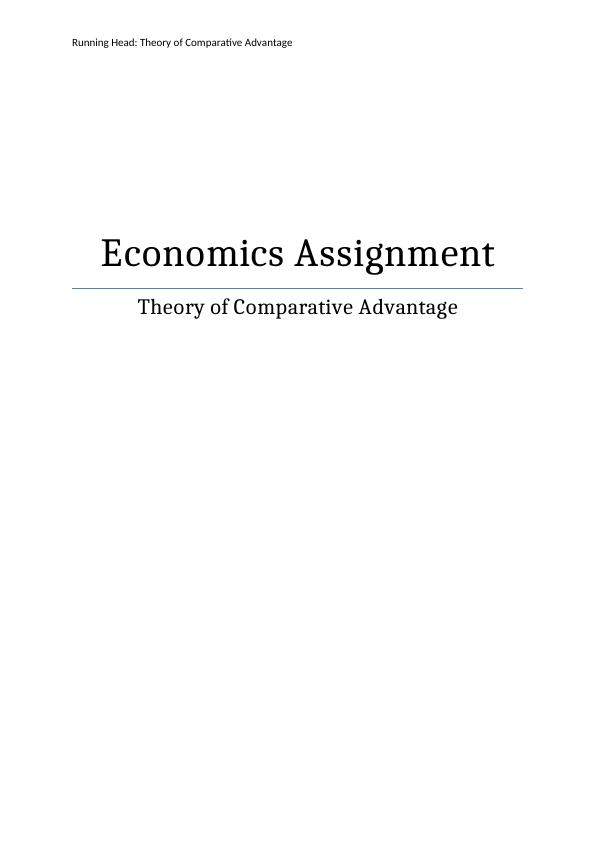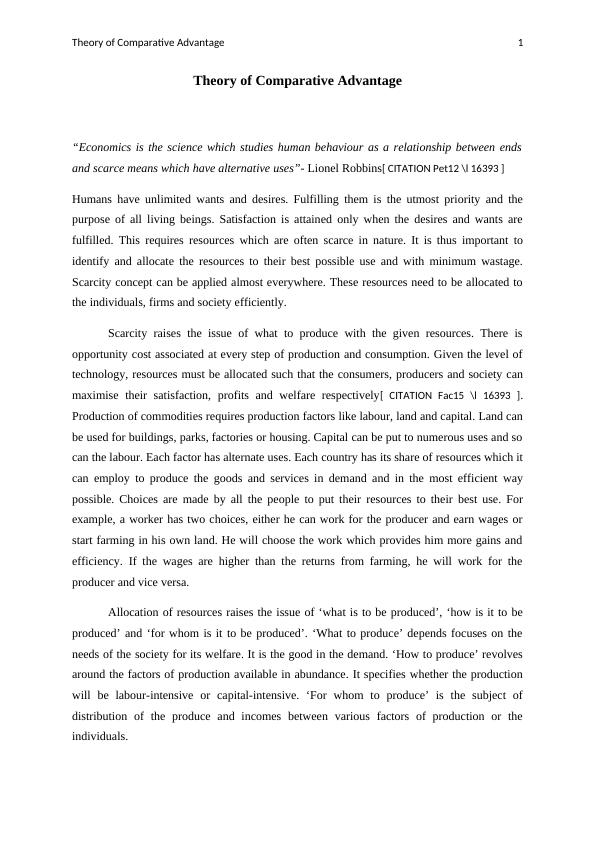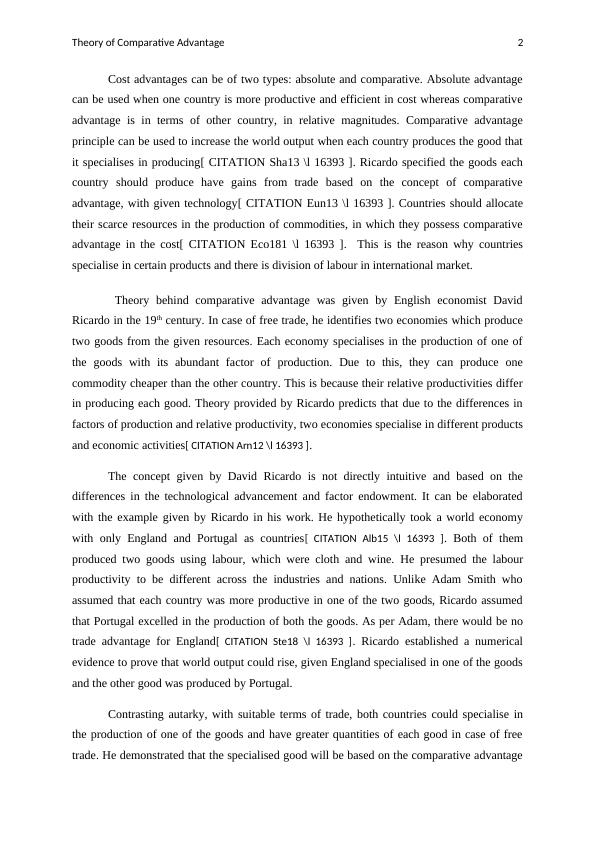Theory of Comparative Advantage : Assignment
Added on 2021-04-19
9 Pages2824 Words77 Views
Running Head: Theory of Comparative AdvantageEconomics AssignmentTheory of Comparative Advantage

Theory of Comparative Advantage1Theory of Comparative Advantage“Economics is the science which studies human behaviour as a relationship between endsand scarce means which have alternative uses”- Lionel Robbins[ CITATION Pet12 \l 16393 ]Humans have unlimited wants and desires. Fulfilling them is the utmost priority and thepurpose of all living beings. Satisfaction is attained only when the desires and wants arefulfilled. This requires resources which are often scarce in nature. It is thus important toidentify and allocate the resources to their best possible use and with minimum wastage.Scarcity concept can be applied almost everywhere. These resources need to be allocated tothe individuals, firms and society efficiently. Scarcity raises the issue of what to produce with the given resources. There isopportunity cost associated at every step of production and consumption. Given the level oftechnology, resources must be allocated such that the consumers, producers and society canmaximise their satisfaction, profits and welfare respectively[ CITATION Fac15 \l 16393 ].Production of commodities requires production factors like labour, land and capital. Land canbe used for buildings, parks, factories or housing. Capital can be put to numerous uses and socan the labour. Each factor has alternate uses. Each country has its share of resources which itcan employ to produce the goods and services in demand and in the most efficient waypossible. Choices are made by all the people to put their resources to their best use. Forexample, a worker has two choices, either he can work for the producer and earn wages orstart farming in his own land. He will choose the work which provides him more gains andefficiency. If the wages are higher than the returns from farming, he will work for theproducer and vice versa.Allocation of resources raises the issue of ‘what is to be produced’, ‘how is it to beproduced’ and ‘for whom is it to be produced’. ‘What to produce’ depends focuses on theneeds of the society for its welfare. It is the good in the demand. ‘How to produce’ revolvesaround the factors of production available in abundance. It specifies whether the productionwill be labour-intensive or capital-intensive. ‘For whom to produce’ is the subject ofdistribution of the produce and incomes between various factors of production or theindividuals.

Theory of Comparative Advantage2Cost advantages can be of two types: absolute and comparative. Absolute advantagecan be used when one country is more productive and efficient in cost whereas comparativeadvantage is in terms of other country, in relative magnitudes. Comparative advantageprinciple can be used to increase the world output when each country produces the good thatit specialises in producing[ CITATION Sha13 \l 16393 ]. Ricardo specified the goods eachcountry should produce have gains from trade based on the concept of comparativeadvantage, with given technology[ CITATION Eun13 \l 16393 ]. Countries should allocatetheir scarce resources in the production of commodities, in which they possess comparativeadvantage in the cost[ CITATION Eco181 \l 16393 ].This is the reason why countriesspecialise in certain products and there is division of labour in international market. Theory behind comparative advantage was given by English economist DavidRicardo in the 19th century. In case of free trade, he identifies two economies which producetwo goods from the given resources. Each economy specialises in the production of one ofthe goods with its abundant factor of production. Due to this, they can produce onecommodity cheaper than the other country. This is because their relative productivities differin producing each good. Theory provided by Ricardo predicts that due to the differences infactors of production and relative productivity, two economies specialise in different productsand economic activities[ CITATION Arn12 \l 16393 ].The concept given by David Ricardo is not directly intuitive and based on thedifferences in the technological advancement and factor endowment. It can be elaboratedwith the example given by Ricardo in his work. He hypothetically took a world economywith only England and Portugal as countries[ CITATION Alb15 \l 16393 ]. Both of themproduced two goods using labour, which were cloth and wine. He presumed the labourproductivity to be different across the industries and nations. Unlike Adam Smith whoassumed that each country was more productive in one of the two goods, Ricardo assumedthat Portugal excelled in the production of both the goods. As per Adam, there would be notrade advantage for England[ CITATION Ste18 \l 16393 ]. Ricardo established a numericalevidence to prove that world output could rise, given England specialised in one of the goodsand the other good was produced by Portugal. Contrasting autarky, with suitable terms of trade, both countries could specialise inthe production of one of the goods and have greater quantities of each good in case of freetrade. He demonstrated that the specialised good will be based on the comparative advantage

End of preview
Want to access all the pages? Upload your documents or become a member.
Related Documents
Fundamentals of Economics PDFlg...
|11
|2464
|33
Fundamentals of economics assignmentlg...
|12
|2348
|33
Assignment on Fundamentals of Economics (pdf)lg...
|12
|2833
|374
Introduction to Economics: Fundamental Problems, Scarcity, Opportunity Cost, and Demandlg...
|6
|829
|312
(PDF) Fundamental of Economicslg...
|13
|3045
|348
Fundamentals of economics - assignmentlg...
|12
|2796
|25
